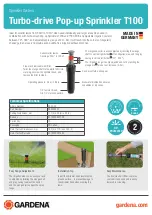
Oxford Technical Solutions Ltd. http://www.oxts.com
Page 23 of 42
b) The cables exit in the same direction but the bases of the antennas are not parallel.
c) The bases of the antennas are parallel and the cables exit in the same direction. This configuration
will achieve the best results.
It is best to mount the two antennas on the top of the vehicle. Although it is possible to mount one on
the roof and one on the bonnet (hood), the multipath reflections from the windscreen will degrade the
performance of the system.
Multipath affects dual antenna systems on stationary vehicles more than moving vehicles and it can
lead to heading errors of more than 0.5° RMS if the antennas are mounted poorly.
It is critical to have the xNAV mounted securely in the vehicle. If the angle of the xNAV can change
relative to the vehicle, then the dual antenna system will not work correctly. This is far more critical for
dual antenna systems than for single antenna systems. The user should aim to have no more than
0.05° of mounting angle change throughout the testing. (If the xNAV is shock mounted then the xNAV
mounting will change by more than 0.05°; this is acceptable, but the hysteresis of the mounting may
not exceed 0.05°).
For both single and dual antenna systems it is essential that the supplied GNSS antenna cables are
used and not extended, shortened or replaced. This is even more critical for dual antenna systems and
the two antenna cables must be of the same specification. Do not, for example, use a 5 m antenna
cable for one antenna and a 15 m antenna cable for the other. Do not extend the cable, even using
special GNSS signal repeaters that are designed to accurately repeat the GNSS signal. Cable length
options are available in 1 m, 5 m and 15 m lengths. This is important because the signal can deteriorate
over longer cables and the signals are expected to match.
xNAV650 orientation and alignment
The orientation of the xNAV in the vehicle is normally specified using three consecutive rotations that
rotate
the xNAV to the vehicle’s co-ordinate frame. The order of the rotations is heading (z-axis rotation),
then pitch (y-axis rotation), then roll (x-axis rotation). It is important to get the order of the rotations
correct or the transformation may not apply correctly.
In the default configuration the xNAV expects its y-axis to be pointing right and its z-axis pointing down
relative to the host vehicle. Please refer to Figure 4 in this manual or see on the top panel of the INS
itself for the correct directions of axes. There are times however when installing an xNAV in the default
configuration is not possible. The xNAV can be mounted at any angle in the vehicle as long as the
configuration is described to the xNAV using NAVconfig. This allows the outputs to be rotated based
on the settings entered to transform the measurements to the vehicle frame.
For ease of use, it is best to try and mount the xNAV so its axes are aligned with the vehicle axes. This
saves the offsets having to be measured by the user. If the system must be mounted misaligned with
the vehicle and the user cannot accurately measure the angle offsets, the xNAV has some functions to
measure these offsets itself. The heading offset can be measured if the vehicle has a non-steered axle.
The Improve Configuration wizard in NAVconfig should be used for this. Roll and pitch offsets can be
measured using the Surface tilt utility in NAVdisplay.
Summary of Contents for xNAV650
Page 1: ...xNAV650 Hardware Manual 20 Years Navigation Experience in one small INS ...
Page 38: ...Oxford Technical Solutions Ltd http www oxts com Page 38 of 42 Appendix 2 Drawings ...
Page 39: ...Oxford Technical Solutions Ltd http www oxts com Page 39 of 42 ...
Page 40: ...Oxford Technical Solutions Ltd http www oxts com Page 40 of 42 Revision history ...
















































